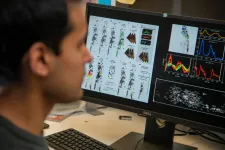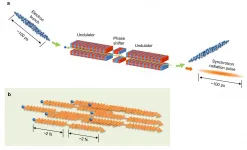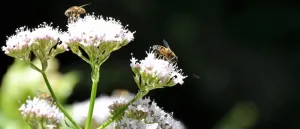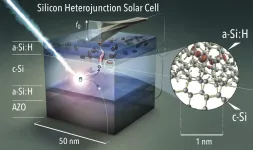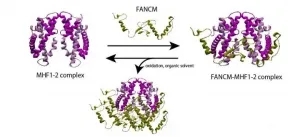(Press-News.org) In researching the causes and potential treatments for degenerative conditions such as Alzheimer's or Parkinson's disease, neuroscientists frequently struggle to accurately identify cells needed to understand brain activity that gives rise to behavior changes such as declining memory or impaired balance and tremors.
A multidisciplinary team of Georgia Institute of Technology neuroscience researchers, borrowing from existing tools such as graphical models, have uncovered a better way to identify cells and understand the mechanisms of the diseases, potentially leading to better understanding, diagnosis, and treatment.
Their research findings were reported Feb. 24 in the journal eLife. The research was supported by the National Institutes of Health and the National Science Foundation.
The field of neuroscience studies how the nervous system functions, and how genes and environment influence behavior. By using new technologies to understand natural and dysfunctional states of biological systems, neuroscientists hope to ultimately bring cures to diseases.
Before that can happen, neuroscientists first must understand which cells in the brain are driving behavior but mapping the brain activity cell by cell isn't as simple as it appears.
No Two Brain Cells Are Alike
Traditionally, scientists established a coordinate system to map each cell location by comparing images to an atlas, but the notion in literature that "all brains look the same is absolutely not true," said Hang Lu, the Love Family Professor of Chemical and Biomolecular Engineering in Georgia Tech's School of Chemical and Biomolecular Engineering.
Taking a coordinate approach presents two main challenges: first, the sheer number of cells in which none look that distinct; second, cells vary from individual to individual.
"This is a current huge bottleneck - you can record neuron activities all you want but if you don't understand which cells are doing what, it's difficult to compare between brains or conditions and draw meaningful conclusions," Lu said.
According to graduate researcher Shivesh Chaudhary, there are also noises in data that make establishing correspondence between two different regions of the brain difficult. "Some deformations may exist in data or some portions of the shape may be missing," he said.
Focusing on Cell Relationships, Not Just Geography
To overcome these challenges, the Georgia Tech researchers borrowed from two disciplines - graphical models in machine learning and metric geometry approach to shape matching in mathematics - and built a computational method to identify cells in their model organism, the nematode C.elegans.
The team used frameworks from other fields such as natural language processing to build their own modeling software. In natural language processing, the computer can determine what sentences mean by capturing dependencies between words in a statement.
The researchers embraced a similar model but instead of capturing dependencies among the words, "We captured them among the neurons to identify cells," Chaudhary said, noting that this approach limits error propagation as compared to other methods that examine the geographic location of each cell.
"Using relationships among the cells was actually more useful in defining a cell's identity," Lu said. "If you define one, you will have the implications of the identity of the other cells."
The approach, say the research team, is significantly more accurate than the current method of identification. The algorithm, while not perfect, performs significantly better in the face of imperfect data, and "gets less rattled" by noise or errors, Lu said.
The algorithm has huge implications for many developmental diseases, since once scientists can understand the mechanism of a disease, they can find interventions.
"You can use this to do drug and genetic screens to assess genetic risks. You can take someone's genetic background and examine how this background makes cells behave differently from the standard reference genetic background," Lu said.
"One cool thing about this approach is that it is data driven, and therefore, it captures the variations among individual worms. This method has a high potential to be applicable to a wide range of studies on development and function under normal as well as disease-like conditions," said Yun Zhang, professor, Department of Organismic and Evolutionary Biology, Center for Brain Science at Harvard University.
Faster Data Analysis
The algorithm greatly accelerates the speed of analyzing whole-brain data. The researchers explained that before this advance, their lab might take 20 minutes to record a set of data, but it would take them weeks to identify cells and analyze data. With the algorithm, the analysis takes "overnight at most on a desktop," said Chaudhary.
The technique also supports crowdsourcing, collaborative online platforms that open up the algorithm to a larger community, which can test the algorithm and build atlases.
"Every researcher working on the same problem could do recordings and contribute to further building these atlases that will be widely usable in all contexts," Lu said.
The researchers credit the success of the project to being able to draw upon multiple disciplines across physics, biology, math, and chemistry. Chaudhary, who has an undergraduate degree in chemical engineering, took advantage of developments in computer science and math to solve this particular neuroscience problem.
"In our labs, we have a physicist working on building microscopes, we have biologists, we have people like me who are inclined more towards computer science. We also collaborate with a pure mathematician," he explained. "The neuroscience field has everything. You can go any direction that you want to."
INFORMATION:
In addition to Lu and Chaudhary, other Georgia Tech researchers contributing to this work were Sol Ah Lee, Yueyi Li, and Dhaval S. Patel.
This research was supported by the National Institutes of Health through awards R21DC015652, R01NS096581, R01GM108962, and R01GM088333 and the National Science Foundation under awards 1764406 and 1707401. Any opinions, findings, and conclusions or recommendations expressed in this material are those of the authors and do not necessarily reflect the views of the sponsoring agencies.
CITATION: S. Chaudhary, et al., "Graphical-Model Framework for Automated Annotation of Cell Identities in Dense Cellular Images." (eLife, 2021)
https://doi.org/10.7554/eLife.60321.
Hydrogen is a pollution-free energy source when it's extracted from water using sunlight instead of fossil fuels. But current strategies for "splitting" or breaking apart water molecules with catalysts and light require the introduction of chemical additives to expedite the process. Now, researchers reporting in ACS ES&T Engineering have developed a catalyst that destroys medications and other compounds already present in wastewater to generate hydrogen fuel, getting rid of a contaminant while producing something useful.
Harnessing the sun's energy to split water to make hydrogen fuel is a promising renewable resource, but it is a slow process even when catalysts are used to speed it along. In some cases, alcohols or sugars are added to boost the rate of hydrogen production, ...
NEW YORK (March 17, 2021) -- High speed air dryers not only leave more contamination on poorly washed hands compared to paper towels, but during hand drying, they can also spread germs onto clothing, ultimately transferring more bacteria to other surfaces, according to a study published today in Infection Control & Hospital Epidemiology, the journal of the Society for Healthcare Epidemiology of America.
Past research has shown recommended handwashing practices for healthcare workers are often not followed with average adherence of 40%. To better understand the impact of hand drying in hand hygiene, researchers conducted an experiment to learn the role of different hand drying methods in spreading germs from poorly washed hands beyond the restroom.
For ...
Scientists in Japan have observed, and interfered with, the ultrafast motion of electron movement inside of a Xenon atom using the coherent pairs of short light waves in synchrotron radiation. Xenon, consisting of a nucleus surrounded by five nested shells containing a total of 54 electrons, is used in flash lamps, and it burns bright and fast. The luminescent electrons move there on a time scale of one billionth of a second. The fast electron movement is however six orders of magnitude slower than that the scientists observed. Using the synchrotron facility at Institute for Molecular Science, they tracked the electron movement in relaxation to shed energy by dropping from an outer shell to an inner shell. The process happens at a timescale of femtoseconds, ...
Researchers at Lund University in Sweden have designed a new bioink which allows small human-sized airways to be 3D-bioprinted with the help of patient cells for the first time. The 3D-printed constructs are biocompatible and support new blood vessel growth into the transplanted material. This is an important first step towards 3D-printing organs. The new study has been published in Advanced Materials.
Chronic lung diseases are the third leading cause of death worldwide with an EU cost of more than €380 billion annually. For many chronic diseases ...
The promotion of psychosocial health among individuals, groups, and society is an increasingly important subject in the field of public health. Psychosocial health is a complex interaction between the psyche of an individual and the social environment in which that individual lives. Promoting psychosocial health is often challenging and complex for health care professionals. Therefore, an important question of public health significance is: "how can we address and improve the psychosocial health of individuals, groups, as well as society in general?"
An interdisciplinary team of specialists ...
The use of artificial light at night around the world has increased enormously in recent years, causing adverse effects on the survival and reproduction of nocturnal organisms. Artificial light at night interferes with vital ecological processes such as the nighttime pollination of plants by nocturnal insects, which could have consequences for agricultural crop yields and reproduction of wild plants.
Scientists from the University of Zurich and Agroscope have now demonstrated for the first time that artificial light at night also adversely affects insects' pollination behavior during the daytime. In an experiment, they used commercial ...
Silicon solar cells are now so cheap and efficient that they can generate electricity at prices of less than 2 cent/kWh. The most efficient silicon solar cells today are made with less than 10 nanometres thin selective amorphous silicon (a-Si:H) contact layers, which are responsible for separating the light-generated charges . Efficiencies of over 24% are achieved at HZB with such silicon heterojunction solar cells and are also part of a tandem solar cell that lead to a recently reported efficiency record of 29.15 % (A. Al-Ashouri, et al. Science 370, (2020)). The current world record from Japan for a ...
Tropical Cyclone (TC) is an intense atmospheric vortex with a warm core and low pressure structure, and generates over the tropical or subtropical warm ocean. The problem of TC genesis has been paid great attention by scientists since the 1950s, but due to the lack of the observation data over sea, this problem has become the most difficult and challenging topic in the researches of TC.
Cumulus convections are considered to be the most basic element in the TC generation process. The formation of TC in the Northwest Pacific is often associated with the mesoscale convective system (MCS) or mesoscale convective complex (MCC). Meanwhile, in the stratiform ...
Not least because of the COVID-19 pandemic, conspiracy theories are more topical than ever. They are reported and discussed in almost all media and communication channels. But what influence do they have on our behavior? Scientists led by behavioral economist Loukas Balafoutas investigated this question in a recently published study. The result: We don't need to believe in conspiracy theories for them to have an impact on us. Merely being confronted with them suffices.
Previous studies have shown that beliefs in conspiracy theories have an influence on the behavior of their adherents. For example, they lead to lower voter turnout or a lower willingness to get vaccinated. For years now, conspiracy theories have been ...
One of the most vital functions performed by the cells in our body is DNA repair, a task so crucial to our well-being that failing to execute it can lead to consequences as dreadful as cancer. The process of DNA repair involves a complex interplay between several gene pathways and proteins. One such pathway is the "Fanconi anemia (FA) pathway," whose genes participate in DNA repair. FANCM, a component of this pathway, is tasked with the elimination of harmful DNA "inter-strand cross-links," and interacts with another component called MHF in order to function. The importance of the FANCM-MHF complex is well-documented: its loss can result in chromosomal ...
